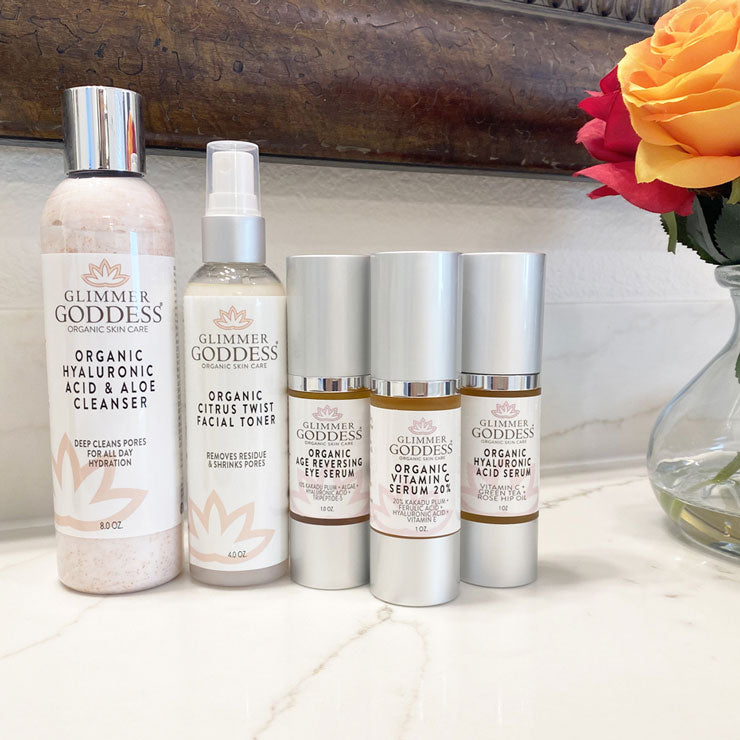
A Guide on How to Patch Test Skincare
Patch testing skincare products is vital for safeguarding against allergic reactions and skin irritations. This guide explains the importance of patch testing, the risks of neglecting it, how to conduct tests, and what ingredients to be cautious of, ensuring you can enjoy your skincare routine with confidence.
The Importance of Patch Testing: Avoiding Allergic Reactions and Skin Irritations
What Are the Risks of Not Patch Testing?
Patch testing is a crucial step in determining skin compatibility, yet many people skip this essential process. Overlooking patch testing can lead to a range of unwanted consequences, from minor irritations to severe allergic reactions.
Ignoring patch testing can put your skin at risk in several ways:
- Potential allergic reactions: Without patch testing, you may expose your skin to ingredients that trigger an allergic response, leading to redness, itching, swelling, or even blistering.
- Skin irritation and inflammation: Certain ingredients, even if not outright allergenic, can still cause irritation, dryness, and inflammation if your skin is not compatible with them.
- Long-term damage: Repeated use of products that your skin is not suited for can lead to chronic issues, such as eczema, dermatitis, or accelerated aging of the skin.
- Wasted time and money: Blindly trying new products without patch testing often results in having to discard them due to adverse reactions, leading to a waste of both your resources and the product.
Patch testing is a simple and effective way to ensure the safety and compatibility of skincare products with your unique skin type. Taking the time to do this can save you from potential discomfort, irritation, and long-term skin damage.
How Can Patch Testing Prevent Allergic Reactions?
Patch testing is a reliable method for identifying potential skin sensitivities and allergic reactions before fully incorporating a new product into your routine.
Here's how patch testing can help prevent allergic reactions:
- Identifies specific allergens: By applying a small amount of the product to a discrete area of your skin and monitoring for any reactions, you can pinpoint which ingredients your skin may be sensitive to.
- Allows for controlled exposure: Patch testing exposes your skin to the product in a controlled, limited manner, giving you the opportunity to observe any adverse reactions in a safe, manageable way.
- Provides peace of mind: Knowing that a product has been patch tested and proven safe for your skin can give you the confidence to use it without fear of experiencing a negative reaction.
- Saves you from a full-body reaction: If you were to apply a product that your skin is allergic to all over your face or body, the reaction could be much more severe and widespread. Patch testing helps you avoid this.
Patch testing is a simple yet effective way to protect your skin and prevent potentially harmful allergic reactions. By taking the time to do this, you can enjoy the benefits of new products without the risk of adverse consequences.
What Ingredients Should Be Patch Tested?
While it's generally recommended to patch test any new skincare product or ingredient, there are certain types of ingredients that warrant extra caution and attention.
Some of the key ingredients that should be patch tested include:
-
Fragrances and essential oils: These are common culprits for triggering skin sensitivities and allergic reactions.
-
AHAs (alpha-hydroxy acids) and retinoids: These potent exfoliating and anti-aging ingredients can be irritating, especially for those with sensitive skin.
-
Preservatives: Preservatives like parabens, formaldehyde, and methylisothiazolinone are known to cause skin irritation and allergies in some individuals.
-
Botanical extracts: Natural ingredients like plant-derived extracts may seem innocent, but they can still trigger reactions in people with specific sensitivities.
-
Newly developed or synthetic ingredients: These lesser-known ingredients pose a higher risk of unexpected reactions and require thorough patch testing.
-
When introducing any new skincare product, it's crucial to patch test all the key ingredients, even if you've used them individually before. Your skin's reaction can vary depending on the specific formulation and combination of ingredients.
Patch testing is an essential step in safeguarding your skin's health and preventing unwanted reactions. By taking the time to thoroughly test new products and ingredients, you can enjoy the benefits of your skincare routine with confidence and peace of mind.
The Importance of Patch Testing: A Guide to Safer Skincare
What Are the Steps in Performing a Patch Test?
Conducting a patch test is a crucial step before introducing a new skincare product into your routine. It allows you to assess your skin's reaction and ensure the product is safe for you to use. Here are the steps involved in performing a proper patch test:
The Patch Test Process
- Choose a small, inconspicuous area of skin, such as the inner arm or behind the ear, to apply the product.
- Cleanse the area and pat it dry to ensure the skin is clean and ready for the test.
- Apply a small amount of the product to the selected area, using a cotton swab or your fingertip.
- Cover the area with a bandage or adhesive dressing to prevent the product from being wiped or washed off.
- Leave the patch test in place for the recommended duration, typically 24-48 hours.
Where Should You Apply the Product for Testing?
The ideal location for a patch test is an area of skin that is thin, sensitive, and hidden from view. This allows you to monitor for any adverse reactions without drawing attention to the test site. Some of the best areas to consider include:
Ideal Patch Test Locations
- Inner forearm: This area is thin-skinned and easily accessible for monitoring.
- Behind the ear: The skin behind the ear is delicate and less exposed, making it a discreet location.
- Crook of the elbow: The inner elbow crease is a common spot for patch testing, as it's sensitive and easy to observe.
- Neck or décolletage: These areas can be good options if you plan to use the product on your face or chest.
How Long Should You Wait Before Assessing the Results?
Patience is key when conducting a patch test. You'll need to wait an appropriate amount of time to allow your skin to fully react to the product before evaluating the results. Here's what you should keep in mind:
Timing the Patch Test
- Wait 24-48 hours: This is the generally recommended timeframe for observing any potential irritation or allergic response.
- Check the area regularly: Inspect the patch test site daily for signs of redness, itching, swelling, or other reactions.
- Extend the test if needed: If you don't notice any immediate issues, you can continue the patch test for up to 72 hours to be extra cautious.
- Discontinue use if any concerns arise: If you experience any discomfort or adverse effects, remove the product immediately and discontinue use.
Patch testing may seem like an extra step, but it's an invaluable way to ensure the safety and compatibility of new skincare products with your unique skin type. By taking the time to properly conduct a patch test, you can avoid potential irritation, allergic reactions, and unnecessary skin distress down the line. Remember, your skin's health and comfort should always be the top priority when trying new cosmetics or treatments.
Understanding Allergic Reactions: A Comprehensive Guide
What Are the Signs of a Positive Reaction?
When it comes to identifying the signs of an allergic reaction, it's crucial to be aware of the various symptoms that can occur. Allergic reactions can manifest in different ways, and recognizing these signs can help you take prompt action and seek appropriate medical attention if necessary.
Recognizing the Symptoms of an Allergic Reaction
- Skin-related symptoms, such as hives, rashes, itching, or swelling
- Respiratory issues, including difficulty breathing, wheezing, or nasal congestion
- Gastrointestinal problems, like nausea, vomiting, or diarrhea
- Cardiovascular changes, including a rapid heartbeat, low blood pressure, or dizziness
When Should You Seek Medical Advice?
While some allergic reactions may be mild and manageable, it's crucial to know when to seek medical assistance. Certain symptoms can indicate a more severe, life-threatening reaction that requires immediate attention.
Identifying Severe Allergic Reactions
- Difficulty breathing or swallowing
- Rapid or weak pulse
- Severe swelling, especially in the face, lips, tongue, or throat
- Dizziness, confusion, or loss of consciousness
- Persistent vomiting or diarrhea
Why Seeking Medical Attention is Important
- Severe allergic reactions, known as anaphylaxis, can be potentially fatal if not treated promptly
- Healthcare professionals can provide appropriate medications, such as epinephrine, to manage the reaction and prevent complications
- They can also help determine the underlying cause of the allergy and develop a plan to prevent or manage future reactions
How to Handle an Allergic Reaction After Testing
If you have undergone an allergy test and experienced a reaction, it's essential to know how to respond effectively. Proper management can help mitigate the symptoms and ensure your safety.
Immediate Steps to Take
- Stay calm and notify the healthcare provider immediately
- If you have been prescribed an epinephrine auto-injector, use it as directed
- Avoid any further exposure to the suspected allergen
- Seek medical attention, even if the reaction appears mild
Ongoing Care and Follow-up
- Work closely with your healthcare provider to identify the specific allergen and develop a comprehensive management plan
- Discuss the use of antihistamines, corticosteroids, or other medications that may help manage future reactions
- Consider carrying an epinephrine auto-injector and learning how to use it properly
- Educate yourself and your loved ones about allergy management and emergency protocols
Allergic reactions can be unpredictable and range in severity, but understanding the signs, seeking timely medical advice, and taking the appropriate steps can make a significant difference in managing these situations effectively. By being proactive and informed, you can take control of your health and navigate the complexities of allergic reactions with confidence.
Q&A
What is patch testing?
Patch testing is a method used to determine how a new skincare product will react with your skin by applying a small amount of the product to a discreet area and monitoring for any adverse reactions.
Why is patch testing important?
Patch testing is important because it helps identify allergens and irritating ingredients, preventing allergic reactions and skin irritations before using a product on larger areas.
How long should I wait to assess a patch test?
Typically, you should wait 24-48 hours to observe any reactions from the patch test. Monitoring the area regularly can help identify any signs of irritation or allergy.
Where should I perform a patch test?
The best areas to perform a patch test are places like the inner forearm, behind the ear, or the crook of the elbow, where the skin is sensitive and easy to monitor.
What ingredients should be patch tested?
Common ingredients that should be patch tested include fragrances, essential oils, AHAs, retinoids, preservatives, and natural extracts, as these can often cause allergic reactions.
Incorporating patch testing into your skincare routine is a crucial practice for preventing potential allergic reactions and skin irritations. By understanding the risks and following the proper testing steps, you can confidently enjoy the benefits of your skincare products without compromising your skin's health.







